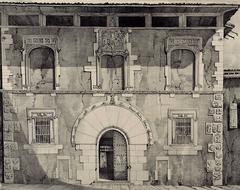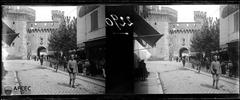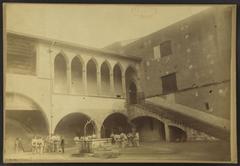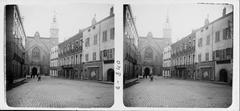
Serrat d’En Vaquer: Visiting Hours, Tickets, and Comprehensive Guide to Perpignan’s Historical Landmark
Date: 04/07/2025
Introduction
Perched on the highest hill of the Roussillon plain, southwest of Perpignan, the Fort du Serrat d’En Vaquer is a singular historical site that seamlessly merges military heritage, paleontological discovery, and panoramic natural beauty. Built in 1885 as part of the French Séré de Rivières defensive system, its semi-buried fortifications and expansive grounds offer a window into 19th-century military strategy—while the site’s construction unearthed significant Pliocene-era fossils, lending it scientific prestige. Today, Serrat d’En Vaquer is an accessible public park, cultural venue, and vantage point for sweeping views of the Pyrenees, Mediterranean Sea, and Catalan landscapes (Camping Le Lagon Argelès; Tourisme Occitanie).
This in-depth guide details the fort’s origins, evolution, visiting information, special features, and its ongoing cultural significance within Perpignan.
Table of Contents
- Historical Background
- Visiting Serrat d’En Vaquer
- On-Site Experience
- Cultural and Community Significance
- Nearby Attractions
- Practical Tips for Visitors
- Frequently Asked Questions (FAQ)
- Visuals and Interactive Media
- Conclusion
- References and Further Reading
Historical Background
Early Military Importance
The strategic importance of the Serrat d’En Vaquer hill dates back to the French Revolutionary Wars. In 1793, it served as the “camp de l’union,” a French encampment during the War of the Pyrenees, where French troops repelled Spanish forces, affirming Perpignan’s defensive significance (Tourisme Occitanie; Perpignan Tourisme).
Séré de Rivières Construction and Strategic Role
The current fort, constructed in 1885, is part of the Séré de Rivières system—a nationwide network of fortifications responding to advances in artillery after the Franco-Prussian War. Its semi-buried, low-profile design and over 40 internal rooms exemplify the era’s military engineering, aimed at maximizing defense while minimizing exposure (Camping Le Lagon Argelès; Tourism Mediterranean Pyrenees).
Obsolescence and Paleontological Discoveries
Advancements in weaponry soon rendered fixed fortifications obsolete, and the fort transitioned to a munitions depot. During its construction, however, workers unearthed a wealth of Pliocene-era fossils—giant tortoises, saber-toothed tigers, rhinoceroses, and straight-tusked elephants—making Serrat d’En Vaquer a key site for paleontological research (Camping Le Lagon Argelès).
Transformation into Civic Landmark
Acquired by the city of Perpignan in 1994, the fort has been restored and opened as a public park. Its sweeping views, military architecture, and educational panels make it a beloved destination for both locals and visitors. Ongoing maintenance ensures preservation and accessibility (Perpignan Tourisme).
Visiting Serrat d’En Vaquer
Location and Getting There
Located southwest of Perpignan, near the Auchan shopping center and the historic Arcades aqueduct, Serrat d’En Vaquer is easily accessible:
- By Car: Ample parking is available nearby (Gralon).
- By Public Transport: The site is a 30–40 minute walk from Perpignan’s train station, or a 20-minute walk from bus stops such as PERPIGNAN – SANKEO Mas Munoz (Visit Occitanie).
Opening Hours and Tickets
- Hours: Open from April to October, Tuesday to Sunday, 10:00 AM–6:00 PM. Closed Mondays and public holidays. The outdoor park is accessible year-round during daylight (Perpignan Méditerranée Tourisme).
- Tickets: Admission is free. Some guided tours or special events may have fees—check with the tourism office for details.
- Booking: Guided tours are popular during festivals and heritage days; advance booking is recommended.
Accessibility and Facilities
- Paths: Main routes are suitable for most visitors; however, interior corridors and historic staircases may be challenging for those with mobility issues (francerent.com).
- Amenities: Benches, shaded areas, and picnic spots are available. Restroom facilities are limited—plan ahead.
- Visitor Advice: Wear sturdy shoes and bring water, especially in warm months.
On-Site Experience
Layout and Panoramic Views
The fort’s 40+ rooms, mostly underground, are surrounded by Mediterranean parkland. Visitors are rewarded with breathtaking 360° vistas of the Pyrenees, Canigou peak, Albères and Corbières mountains, and the Mediterranean (tourism-mediterraneanpyrenees.com; Les Pyrénées-Orientales).
Walking Paths and Flora
Well-marked trails wind through 12 hectares of native Mediterranean flora. Informative signs detail the site’s botany and geology. The park is especially scenic in spring and autumn, and sheep sometimes graze the grounds, reflecting local traditions (Les Pyrénées-Orientales).
Historical Interpretation and Paleontology
Interpretive panels narrate the fort’s role in Franco-Spanish relations, its architectural features, and its paleontological discoveries—including Testudo perpiniana and Dolichopithecus ruscinensis (loisirs66.fr). Fossil highlights are referenced onsite, with further exhibits in local museums.
Cultural and Community Significance
Events and Living Heritage
Serrat d’En Vaquer is a lively venue for open-air concerts, art exhibitions, and the annual Trobades Médiévales festival, which celebrates Perpignan’s medieval and Catalan roots (voyagesetdecouvertes.com). Local associations organize thematic tours and community events.
Catalan Identity and Social Evolution
The site reflects Perpignan’s layered identity. Once a discreet meeting place for the LGBTQ+ community, it has evolved into a family-friendly park, mirroring broader inclusivity trends (actu.fr). The hill is a focal point for Catalan festivals, music, and gatherings.
Nearby Attractions
- Aqueduc des Arcades: A 14th-century aqueduct visible from the site.
- Palace of the Kings of Majorca: A 13th-century fortress in Perpignan.
- Perpignan Old Town: Rich in Catalan culture, markets, and museums.
- Natural History Museum: Exhibits regional geology and paleontology (Gralon).
- Lac de la Raho: Nearby lake for swimming, cycling, and birdwatching.
Practical Tips for Visitors
- Best Time: Spring and autumn offer mild weather and vibrant scenery.
- What to Bring: Sturdy shoes, water, sun protection, camera, and binoculars for birdwatching.
- Safety: Supervise children near underground areas; respect heritage signage and wildlife.
- Language: French is primary; some information is available in English and Catalan.
Frequently Asked Questions (FAQ)
Q: Are there entrance fees or tickets required?
A: Admission is free; tickets are only required for guided tours or special events.
Q: What are the visiting hours?
A: Generally 10:00 AM–6:00 PM (April–October); outdoor park accessible year-round during daylight.
Q: Is the site accessible for people with mobility issues?
A: Main paths are accessible; some historic areas have uneven ground or stairs.
Q: Are guided tours available?
A: Yes, seasonally and during festivals—check with the tourism office for schedules.
Q: Can I bring children or pets?
A: Yes; supervise children, keep pets on a leash, and follow site rules.
Visuals and Interactive Media
For a preview of the site’s architecture and stunning landscapes, explore the official tourism portals, which offer high-quality images, virtual tours, and interactive maps (Perpignan Tourisme). Recommended alt tags include “Panoramic view from Serrat d’En Vaquer Perpignan” and “Historic fort at Serrat d’En Vaquer Perpignan.”
Conclusion
Serrat d’En Vaquer is a cultural landmark that bridges Perpignan’s military past, scientific discovery, and dynamic community life. Its free access, educational panels, and lively calendar of events make it an essential stop for anyone exploring southern France. Plan your visit for a rich blend of history, nature, and Catalan heritage—and don’t forget to download the Audiala app for guided tours and insider tips.
References and Further Reading
- Fort du Serrat d’En Vaquer: History, Visiting Hours, Tickets, and Attractions in Perpignan (Camping Le Lagon Argelès)
- Fort du Serrat d’En Vaquer, Perpignan (Tourisme Occitanie)
- Fort du Serrat d’En Vaquer (Tourism Mediterranean Pyrenees)
- Serrat d’En Vaquer Visiting Information (Perpignan Tourisme)
- Serrat d’En Vaquer Visitor Guide (Loisirs66.fr)
- Serrat d’En Vaquer Visitor Experience (Anglophone Direct)
- Serrat d’En Vaquer Paleontological Significance (Wikipedia)
- Cultural and Social Significance (Actu.fr)
- Perpignan’s Historical Sites and Cultural Events (Voyages et Decouvertes)
- Fort Serrat Vaquer Visitor Information (Guide Tourisme France)









